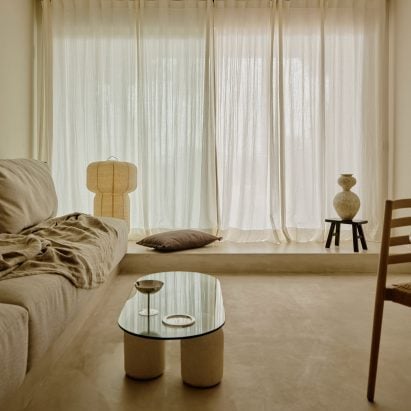Valencia-based studio Paloma Bau incorporated architectural detailing when renovating this seaside apartment, which was designed to nod to East Asian and Mediterranean interiors.
Named Mediterrasian, the 55-square-metre apartment is located in the coastal city of Dénia and serves as the owner’s holiday home.
Originally built in 2008, Paloma Bau made a number of changes to the apartment as part of the renovation but kept its existing structural elements.
The interior has a neutral colour scheme and material palette
“We needed to correct the typical shortcomings found in standard housing: awkward ceiling drops for technical installations, clumsy pillar integration, unnecessary build-ups and poorly resolved material junctions,” said the studio.
Paloma Bau aimed to mitigate those pitfalls through carefully considered architectural detailing, intended to make the space as coherent and streamlined as possible.
Built-in elements reminiscent of traditional Mediterranean architecture help to soften the interior. In the bathrooms, these manifest as shelving integrated into curved corners, which also help to zone the shower area.
Built-in nooks and shelving create a streamlined effect
Recessed shelving also features in the living room and bedrooms alongside integrated, smooth-fronted cabinets, creating opportunities for storage without visual clutter.
“Mediterranean influences are also present in the ceramic light fixtures – reinterpretations of traditional roof tiles once used to illuminate exteriors – as well as in the use of natural fibre furniture and linen fabrics,” Paloma Bau told Dezeen.
In the living space, custom-built volumes serve as both bases for the sofa and steps up onto the terrace, while an archway leads into the kitchen.
This arched motif is reflected in a floor-to-ceiling sliding door that separates the shared and private spaces, which was made from translucent, dappled glass and features arc-shaped tracery.
“The sliding door was designed from scratch, inspired by Japanese wooden-and-paper panels – here, those materials were reimagined in metal and cathedral glass, evoking the movement of ocean waves,” the studio said.
A glass sliding door separates the entertaining and private zones
As well as the door, East Asian-style furnishings such as rice paper lampshades and sheer linen curtains also feature elsewhere in the interior.
These light and airy elements were offset by dark hardware on the doors, while the varied textures are unified by the consistent presence of light-coloured oak cabinetry and shelving in most of the rooms.
Sheer curtains create privacy while letting light in
“The warmth and tactile richness of the Mediterranean is balanced with the restraint, clarity and spatial mindfulness drawn from Asian design sensibilities,” said the studio.
“This fusion materialises in the neutral palette, the formal restraint, and the interplay between the artisanal and the architectural.”
Other Spanish apartments with warm, neutral design schemes that we’ve published on Dezeen before include a pared-back Madrid apartment by Matteo Ferrari and Carlota Gallo and an early 20th-century flat in Barcelona decorated by original features rather than bright colours.
The photography is by David Zarzoso.
The post Beachfront Spanish apartment blends “the artisanal and the architectural” appeared first on Dezeen.
